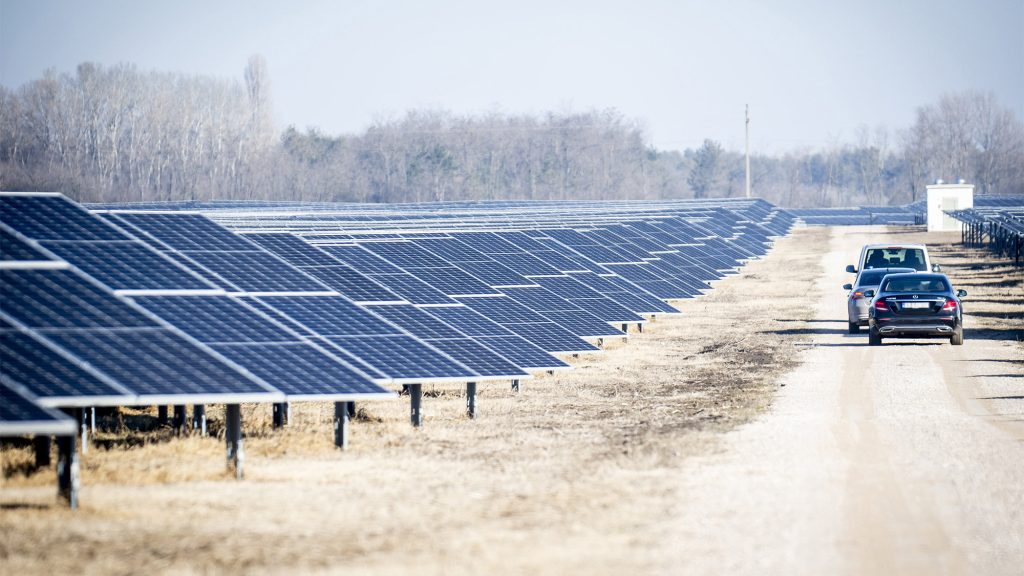According to independent global energy think-tank EMBER, Hungary has the planet’s third highest share of solar energy in domestic electricity production. The Ministry of Energy has presented this data as a world-class achievement. In 2023, Hungary generated 18.4 per cent of its electricity with solar power plants, surpassed only by two warmer climate countries, Chile (19.9 per cent) and Greece (19 per cent) – the Central European country outperformed solar powerhouses like Australia, Germany, and Spain.
According to the Ministry, the result is primarily due to the significant solar energy capacities that have been recently developed in Hungary. The expansion rate set records with approximately 1.1 gigawatts in 2022 and more than 1.6 gigawatts in 2023. In this year’s February, the total installed capacity of solar systems exceeded the previous target of 6 gigawatts set for 2030.
According to representatives of domestic solar organisations, there is no reason to doubt the credibility of EMBER’s data. In fact, this year Hungary is even expected to climb to the second place globally, thanks to new plants coming online one after another as the result of projects that had started years ago. The result also reflects that in Hungary,
Less eagerness to display consumption data
The data cherry-picked by the Ministry, however, has several caveats. Compared to the rest of Europe, Hungary is at the last or second-to-last place year after year in terms of the share of domestic electricity production. Which means that by international standards, there is an
According to the data of MAVIR, the state company responsible for operating Hungary’s power grid, 25.4 per cent of the country’s total gross electricity consumption was imported in 2023. The import share was 27.2 per cent back in 2021, after which both production and consumption decreased.
With a domestic gross electricity production of 34.8 thousand gigawatt-hours (GWh), electricity imports amounted to nearly 20 thousand GWh, of which about 9 thousand GWh was re-exported. Compared to its potential, Hungary produces a meagre amount domestically. The main problem with this is that
– evaluated Ernő Kiss, president of the Hungarian Photovoltaic and Solar Collector Association (MNNSZ) to our newspaper.
Kiss believes this is particularly unfavourable considering that before 1990, Hungary was practically self-sufficient in electricity.

Another slightly disheartening fact highlighted by the data promoted by the Ministry is the disproportionately large share of solar energy within the domestic renewable energy production mix. According to the energy authority, energy production of solar power plants increased by 38.1 per cent to 6,537 GWh last year, while wind power plants produced only a tenth of this amount, 644 GWh. In terms of capacity, the ratio is even worse: the installed capacity of solar panels is slightly more than 6,000 megawatts, compared to the only 350 megawatts of the country’s wind turbines.
Due to the administrative restrictions of the Orbán administration, no wind power plants have been built in Hungary since 2011, while wind energy has been booming not only across Europe but also globally over the past decade.
as they complement each other well: wind power plants are more productive in the winter months, while solar plants perform better in the summer.
When discussing the one-sidedness of the Ministry’s data, another important factor is that geothermal energy developments have been lagging behind in Hungary, despite the country’s globally outstanding geological conditions.

Solar sector performing far below its potential
How is it possible that solar capacity expansion has broken records in the past two years, while the government has been placing administrative obstacles in the way of new developments since 2021? First came a quasi-ban on the authorisation of commercial and industrial consumption-reducing solar plants, followed by the suspension of feed-in opportunities for household-sized small power plants in 2022. The restrictions on the latter two categories were later largely or entirely lifted.
Associations across the industry think that
Since the development of solar power systems is a very lengthy process in Hungary, these older projects will continue to significantly increase capacities even in 2024. The boom was also staggering regarding household-sized plants —their installed capacity increased from 0.72 gigawatts in 2020 to 2.32 gigawatts in 2023, according to MAVIR. In their case, the dreams were shattered by the feed-in stoppage and the transition from net to gross metering.
Citing limited network capacities, the government thus allows a narrow scope for the solar sector. However, both residential and investor interest would call for much more than what these limited horizons permit. At this March’s publication procedure, the Ministry of Energy reported of an unexpectedly high interest by investors, targeting the installation of about 5 gigawatts of commercial plant capacity and 2.5 gigawatts of storage capacity.
Following the continuous trend since 2021, the energy authority has decided that new commercial-sized solar power plants that would feed back to the grid will not be granted connection opportunities this year, either. What’s new about the announcement is that the Ministry also stated that such developers cannot expect connection opportunities until 2030, and thus the regular publication procedures are suspended as well.
With this they prevent the construction of solar plants financed by investors. Instead, it’s most likely that gas turbine plant capacities will be built with public funds.
All while a gigantic portion of electricity imports could be replaced without any support” – commented Ernő Kiss.
The cabinet, however, gives green light to newly built industrial consumption-reducing solar power plants that do not operate on a feed-in basis. As we have also reported – based on Vsquare’s information – Chinese companies building battery and electric car factories have realised that the Orbán government is unable to meet their energy needs, so they will generally build their own solar power plants. These solutions will most likely be the driver behind the domestic solar sector in the near future.
As of yet, there is no unequivocal explanation to the question why policymakers continuously scrap capacity tenders while citing the limited capacity of Hungary’s power grid. According to Kiss,
giving way to distortions in data reporting, too. As per the official position of MAVIR and network distribution companies, capacity shortages are indeed prevalent, a condition that has been unchanging for years. However, nowhere else in Europe is the expansion of solar energy restricted due to network load.

Meanwhile, in 2024, the Utility Cost Protection Fund, now bloated to 1340 billion forints, could easily provide resources for the distribution network’s development, especially amidst today’s plummeting energy prices.
Residential sector at rock bottom
The solar sector is currently performing very poorly, with no new developments due to capacity shortages and the various restrictions. Projects authorised years ago are the only things contractor companies have to work on. These projects are still expected to provide the industry with some momentum this year, but the residential sector’s downturn is total.
The phasing out of net metering and the introduction of gross metering, offering much less favourable returns,
have caused a shock across the sector from which no one has recovered
– claimed Ádám Szolnoki, president of MANAP Industry Association, to our newspaper.
With the new accounting rules, private clients hardly ever consider installing solar systems anymore, while most of the many projects started under the previous regime have run their course. Consequentially, layoffs are on the agenda for contractor companies, with businesses shutting down, moving abroad, or changing their profile to focus on general electrical work instead – Szolnoki explained the situation.
In addition to the delays in payments for the EU-funded residential solar program since 2022, similar problems are anticipated in the government’s budget-funded 2024 solar program, too. The Ministry only announced last week that the payments for the 75 billion-forint program have begun.
On a positive note, it could be pointed out that Hungary has now come very close to meeting its commitment to the European Commission targeting 12 gigawatts of installed solar capacity by 2030. Besides already operating plants, projects that have only been granted the possibility of grid connection are also counted towards this objective – he added.




